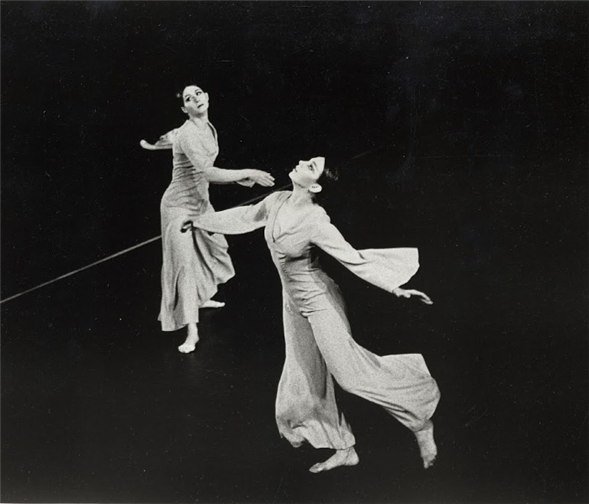Translate Page

The legendary dance-maker reflects on her early years in Minimalism and Me
---
In 1965, a very brief, rather odd dance performance took place in a Hunter College art studio. The choreographer was an unknown named Twyla Tharp, who had graduated from Barnard College two years earlier with an art history degree, and danced briefly with Paul Taylor's company. The title of the program's single work, Tank Dive, reflected "Tharp's belief that becoming a successful choreographer is equivalent to the chances of successfully diving into a thimbleful of water from a great height," according to the entry on her website's wonderfully detailed listing of her oeuvre.
As has long been evident, Tharp's risky plunge paid off big time. That first piece may not have made a major splash, but she kept working diligently, methodically investigating the possibilities of movement and applying increasingly complicated ideas as she presented new works at a dizzying pace wherever she could: in museums, on lawns, in college gyms.
That budding era of Tharp's career is the focus of Minimalism and Me, which kicks off this week at the Joyce Theater and runs through December 9. With her distinctive rigor, erudition and wit, Tharp guides audiences through a series of her earliest dances created between 1965 and 1971. In addition to excerpts of never-seen pieces performed by her current ensemble, she shares artifacts from that period, including archival photos and intricate drawings she made to illustrate the complex patterns and problem-solving concepts in her dances. The evening closes with her landmark 1971 work Eight Jelly Rolls -- her first dance created with a proscenium stage in mind -- set to vintage jazz by Jelly Roll Morton.
Lest anyone accuse the 77-year-old of indulging in nostalgia, she's quick to banish that thought. "I don't think of it as looking back, because it's being put in a different context," she says about the work. "I'm not reconstructing. Essentially, what I'm doing here is an accounting of this period, both in terms of visuals that haven't been seen -- photographs, films, drawings -- and also a few excerpts from some of the pieces. But they're put in the context of the era. The first half is about, 'Okay folks, this is how it all started.' Giving that reference to an audience now, I think, is relevant and forward-thinking. I'm not interested in revisiting the past. I'm interested in how does this reflect now? And, always of course, what have we got here that's going to survive?"
{Image1}
Tharp was motivated to reexamine her early days last year, when the Museum of Contemporary Art Chicago commissioned her to create a performance inspired by its minimalist collection, visual artists such as Robert Morris, Richard Serra and Carl Andre who emerged at the same time she did. The Joyce program has evolved a bit, and Tharp presents everything chronologically in order to trace her progression.
"It spans from the very beginning, Tank Dive, which is essentially static movement; to Re-Moves (1966), which moves static movement locomotive-style through space; into Generation (1968), which is about invention in terms of movement, asking what can the body do?" she says. "Then there is Medley (1969), which is totally different. In Generation the dancers are separated, but then community came into effect in Medley."
Tharp also touches on another 1969 work, Dancing in the Streets of London and Paris, continued in Stockholm, and sometimes Madrid, which originally meandered through galleries in Hartford, CT's Wadsworth Atheneum Museum of Art, and was presented at the Metropolitan Museum of Art the next year. A half-century later, dance performed in museums is all the rage, but Tharp got there first.
Speaking of dance and museums, Tharp's early years of experimentation and self-education as a choreographer overlapped with the Judson Dance Theater, a collective whose work is the subject of a current MoMA exhibition. When asked whether she had any connection to those artists, she says, "I only did two shows at Judson -- end of story -- but we rehearsed in the gym a lot. We used it as a studio. I was the same then as I am now: I work. I don't deal in culture -- I make dances."
And make them she certainly does, for several generations of terrific dancers in her eponymous troupe, and also for ballet companies, movies, Broadway and beyond. Troupes all over the world perform her work. Next month, The Golden Section (1983) is part of Alvin Ailey American Dance Theater's holiday season at City Center and, in the spring, American Ballet Theatre will add Deuce Coupe (1973) to its repertory.
But while you can see her work in many places, Minimalism and Me gives fans an unprecedented opportunity to view her beginnings through her eyes. "I don't look on it as history; I look on it as, hopefully, valuable information, in terms of movement," she says. "I don't have the answers, I just ask the questions."
---
TDF MEMBERS: At press time, discount tickets were available for Twyla Tharp at the Joyce in seating range A and B. Go here to browse our current offers.
Susan Reiter regularly covers dance for TDF Stages.
Top image: Twyla Tharp and Graciela Figueroa. Photo by Jack Mitchell.